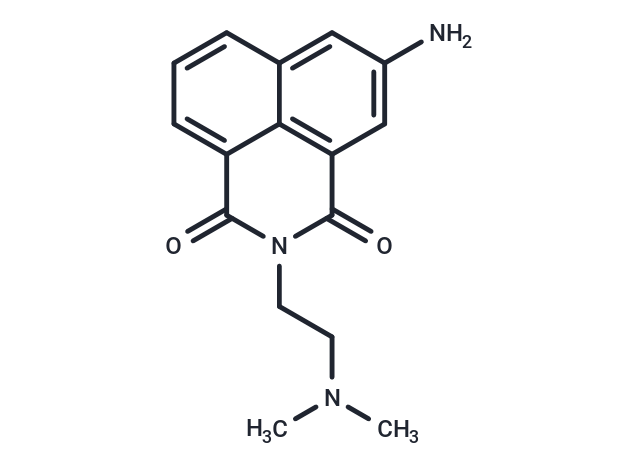Shopping Cart
- Remove All
 Your shopping cart is currently empty
Your shopping cart is currently empty

Amonafide (NSC-308847,AS1413)(AS1413) produces protein-associated DNA-strand breaks through a topoisomerase II-mediated reaction, but does not produce topoisomerase I-mediated DNA cleavage.

| Pack Size | Price | Availability | Quantity |
|---|---|---|---|
| 1 mg | $33 | In Stock | |
| 2 mg | $47 | In Stock | |
| 5 mg | $73 | In Stock | |
| 10 mg | $89 | In Stock | |
| 25 mg | $166 | In Stock | |
| 50 mg | $296 | In Stock | |
| 100 mg | $491 | In Stock | |
| 1 mL x 10 mM (in DMSO) | $84 | In Stock |
| Description | Amonafide (NSC-308847,AS1413)(AS1413) produces protein-associated DNA-strand breaks through a topoisomerase II-mediated reaction, but does not produce topoisomerase I-mediated DNA cleavage. |
| In vitro | Through a topoisomerase II-mediated reaction, Amonafide treatment produces DNA single-strand breaks (SSB), double-strand breaks (DSB), and DNA-protein cross-links in human myeloid leukemia cells. Amonafide treatment inhibits conlony formation of the leukemic cell lines and the normal human bone marrow GM-CFC in a dose-dependent manner. Amonafide does not produce topoisomerase I-mediated DNA cleavage even at 100 μM. The m-AMSA-resistant line is less than 2-fold resistant to Amonafide [1] Amonafide interferes with the DNA breakage-reunion activity of mammalian DNA topoisomerase II resulting in DNA cleavage stimulation. [2] Compared with those of other antitumor drugs, Amonafide-stimulated cleavage intensity patterns are markedly different. Amonafide highly prefers a cytosine, and excludes guanines and thymines instead, at position -1, with lower preference for an adenine at position +1. [3] Topoisomerase II-mediated DNA cleavage induced by Amonafide is affected only slightly (less than 3-fold) by 1 mM ATP, suggeting that Amonafide is an ATP-insensitive topoisomerase II inhibitor in contrast to doxorubicin, etoposide, and mitoxantrone. [4] Amonafide significantly inhibits the growth of HT-29, HeLa, and PC3 cells with IC50 of 4.67 μM, 2.73 μM, and 6.38 μM, respectively. [5] Amonafide is unaffected by P-glycoprotein-mediated efflux, unlike those of the classical topoisomerase II inhibitors (daunorubicin, doxorubicin, idarubicin, etoposide, and mitoxantrone). [6] |
| Cell Research | All cell lines are in the logarithmic phase of growth when the assay of 3-(4,5-dimethylthiazol-2-yl)-2,5-diphenyltetrazolium bromide (MTT) is carried out. Cells are harvested and seeded into 96-well tissue culture plates at a density of 2.5 × 103 cells/well in 150 μL aliquots of medium. The concentrations tested are serial dilutions of a stock solution (10 μM in DMSO) with phosphate-buffered saline (PBS) and are added 24 hours later. The assay is ended after 72 hours of Amonafide exposure and PBS is used as a negative control. After 72 hours treatment, cells are washed twice with PBS, and then 50 μL/well of MTT reagent (1 mg/mL in PBS) together with 150 μL/well of prewarmed medium are added. The plates are returned to the incubator for 4 hours. Subsequently, DMSO is added as solvent. Absorbance is determined at 570 nm with a Microplate reader. All experiments are performed at least three times, and the average of the percentage absorbance is plotted against concentration. Then, the concentration of Amonafide required to inhibit 50% of cell growth (IC50) is calculated for Amonafide.(Only for Reference) |
| Alias | Quinamed, NSC308847, Nafidimide, AS1413 |
| Molecular Weight | 283.33 |
| Formula | C16H17N3O2 |
| Cas No. | 69408-81-7 |
| Smiles | CN(C)CCN1C(=O)c2cccc3cc(N)cc(C1=O)c23 |
| Relative Density. | 1.306 g/cm3 (Predicted) |
| Storage | Powder: -20°C for 3 years | In solvent: -80°C for 1 year | Shipping with blue ice. | ||||||||||||||||||||||||||||||||||||||||
| Solubility Information | DMSO: 53 mg/mL (187.06 mM), Sonication is recommended. Ethanol: 4 mg/mL (14.12 mM), Sonication is recommended. H2O: < 1 mg/mL (insoluble or slightly soluble) | ||||||||||||||||||||||||||||||||||||||||
Solution Preparation Table | |||||||||||||||||||||||||||||||||||||||||
Ethanol/DMSO
DMSO
| |||||||||||||||||||||||||||||||||||||||||

Copyright © 2015-2025 TargetMol Chemicals Inc. All Rights Reserved.